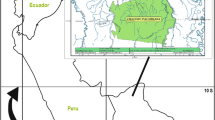Abstract
Ethnobotanists use a variety of interview techniques to collect ethnobotanical data. Drawing upon the results from a quantitative ethnobotanical study in five Yuracaré and Trinitario communities in the Bolivian Amazon, the pros and cons of the following methods are evaluated: (1) interviews in situ during transects, walk-in-the-woods, and homegarden sampling; and (2) interviews ex situ with fresh plant material, voucher specimens, or plant photographs as reference tools. Although the systematic use of plant photographs for ethnobotanical interviews is poorly documented in literature, the results show that indigenoùs participants in our study recognize significantly more plant species from photographs than from voucher specimens. It is argued that, especially in remote and isolated study sites, photographs might be advantageous over voucher specimens.
Similar content being viewed by others
Literature Cited
Albuquerque, U. P., L. H. C. Andrade, and J. Caballero. 2005. Structure and Floristics of Homegardens in Northeastern Brazil. Journal of Arid Environments 62:491–506.
Alexiades, M. N. 1996. Collecting Ethnobotanical Data: An Introduction to Basic Concepts and Techniques. Pages 53–94 in M. N. Alexiades, ed. Selected Guidelines for Ethnobotanical Research: A Field Manual. The New York Botanical Garden, New York
Atran, S., D. Medin, N. Ross, E. Lynch, V. Vapnarsky, E. U. Ek’, J. Coley, C. Timura, and M. Baran. 2002. Folkecology, Cultural Epidemiology, and the Spirit of the Commons. Current Anthropology 43:421–450.
Bennett, B. 1992. Plants and People of the Amazonian Rainforest: The Role of Ethnobotany in Sustainable Development. Bioscience 42:599–607.
Bennett, B., M. A. Baker, and P. Gomez Andrade, eds. 2002. Ethnobotany of the Shuar of Eastern Ecuador. Advances in Economic Botany 14.
Bernstein, J. H., R. Ellen, and B. B. Antaran. 1997. The Use of Plot Surveys for the Study of Ethnobotanical Knowledge: A Brunei Dusun Example. Journal of Ethnobiology 17:69–96.
Boom, B. 1987. Ethnobotany of the Chacobo Indians. Advances in Economic Botany 4:1–68.
D’Andrade, R. G. 1987. Modal Responses and Cultural Expertise. American Behavioral Scientist 31:194–202.
Davis, A., and J. R. Wagner 2003. Who Knows? On the Importance of Identifying “Experts” When Researching Local Ecological Knowledge. Human Ecology 31:464–489.
Davis, E. W., and J. A. Yost 1983. The Ethnobotany of the Waorani of Eastern Ecuador. Botanical Museum Leaflets 29:159–217.
DeWalt, S. J., G. Bourdy, L. R. Chávez de Michel, and C. Quenevo. 1999. Ethnobotany of the Tacana: Quantitative Inventories of Two Permanent Plots of Northwestern Bolivia. Economic Botany 53: 237–260.
Emmison, M., and P. Smith. 2000. Researching the Visual: Images, Objects, Contexts and Interactions in Social and Cultural Inquiry. Sage, London.
Kainer, K. A., and M. L. Duryea. 1992. Tapping Women’s Knowledge: Plant Resource Use in Extractive Reserves, Acre, Brazil. Economic Botany 46:408–425.
Martin, G. J. 1995. Ethnobotany: A Methods Manual. Chapman and Hall, London.
Nguyen M. L. T. 2003. Comparison of Food Plant Knowledge between Urban Vietnamese Living in Vietnam and in Hawai’i. Economic Botany 57:472–480.
Phillips, O. L., and A. H. Gentry. 1993a. The Useful Plants of Tambopata, Peru: I. Statistical Hypotheses Tests with a New Quantitative Technique. Economic Botany 47:15–32.
——. 1993b. The Useful Plants of Tambopata, Peru: II. Additional Hypotheses Testing in Quantitative Ethnobotany. Economic Botany 47:33–43.
——, C. Reynel, P. Wilkin, and B. C. Galvez-Durand. 1994. Quantitative Ethnobotany and Amazonian Conservation. Conservation Biology 8:225–248.
— and J. Miller 2002. Global Patterns of Forest Diversity: The Dataset of Alwyn H. Gentry. Monographs in Systematic Botany 89. Missouri Botanical Garden, St. Louis, Missouri.
—, R. Vásquez Martinez, P. Núñez Vargas, A. Lorenzo Monteagudo, M.-E. Chuspe Zans, W. Galiano Sánchez, A. Peña Cruz, M. Timana, M. Yli-Halla, and S. Rose. 2003. Efficient Plot-Based Floristic Assessment of Tropical Forests. Journal of Tropical Ecology 19:629–645.
Plotkin, M. J. 1994. Tales of a Shaman’s Apprentice. An Ethnobotanist Searches for New Medicines in the Amazon Rainforest. Penguin Books, New York.
Querejazu, R. L. 2005. La Cultura de los Yuracarés, su Hábitat y su Proceso de Cambio. Impresiones Poligraf, Cochabamba, Bolivia.
Reyes-Garcia, V., E. Byron, V. Vadez, R. Godoy, L. Apaza, E. P. Limache, W. R. Leonard, and D. Wilkie. 2003. Measuring Culture as Shared Knowledge: Do Data Collection Formats Matter? Cultural Knowledge of Plant Uses among Tsimane’ Amerindians, Bolivia. Field Methods 15:1–22.
Rico Pareja, A., T. Beetstra, and F. M. Rocha Torrez. 2005. Atlas del Trópico de Cochabamba. Talleres Gráficos “KIPUS,” Cochabamba, Bolivia.
Riester, J. ed. 1976. En Busca de la Loma Santa. Editorial Los Amigos del Libro, La Paz-Cochabamba, Bolivia.
Thomas, E., and I. Vandebroek. 2006. Guía de Plantas Medicinales de los Yuracarés y Trinitarios del Territorio Indígena Parque Nacional Isiboro-Sécure, Bolivia. Imprenta Sirena, Santa Cruz, Bolivia.
Van Andel, T. 2000. Non-Timber Forest Products of the North-West District of Guyana. Part I. Tropenbos-Guayana Series 8a, Utrecht University, The Netherlands.
Van Gijn, E. 2006. A Grammar of Yurakaré. Nijmegen University, The Netherlands.
Vandebroek, I., J.-B. Calewaert, S. De Jonckheere, S. Sanca, L. Semo, P. Van Damme, L. Van Puyvelde, and N. De Kimpe. 2004a. Use of Medicinal Plants and Pharmaceuticals by Indigenous Communities in the Bolivian Andes and Amazon. Bulletin of the World Health Organization 82:243–250.
—, P. Van Damme, L. Van Puyvelde, S. Arrazola, and N. De Kimpe. 2004b. A Comparison of Traditional Healers’ Medicinal Plant Knowledge in the Bolivian Andes and Amazon. Social Science and Medicine 59:837–849.
—, E. Thomas, and AMETRAC. 2003. Plantas Medicinales para la Atención Primaria de la Salud. El Conocimiento de Ocho Médicos Tradicionales de Apillapampa (Bolivia). Indústrias Gráficas Serrano, Cochabamba, Bolivia.
Voeks, R. A. 2004. Disturbance Pharmacopoeias: Medicine and Myth from the Humid Tropics. Annals of the Association of American Geographers 94:868–888.
Author information
Authors and Affiliations
Corresponding author
Rights and permissions
About this article
Cite this article
Thomas, E., Vandebroek, I. & Van Damme, P. What works in the field? A comparison of different interviewing methods in ethnobotany with special reference to the use of photographs. Econ Bot 61, 376–384 (2007). https://doi.org/10.1663/0013-0001(2007)61[376:WWITFA]2.0.CO;2
Received:
Revised:
Accepted:
Issue Date:
DOI: https://doi.org/10.1663/0013-0001(2007)61[376:WWITFA]2.0.CO;2




